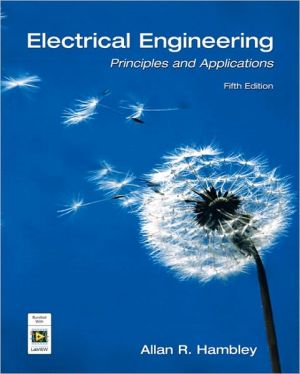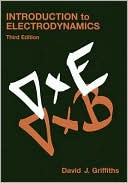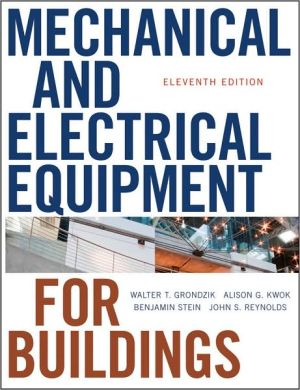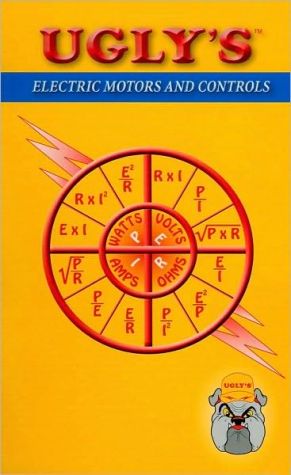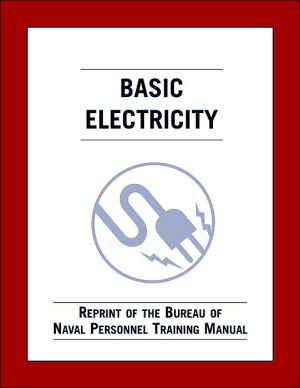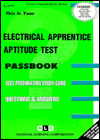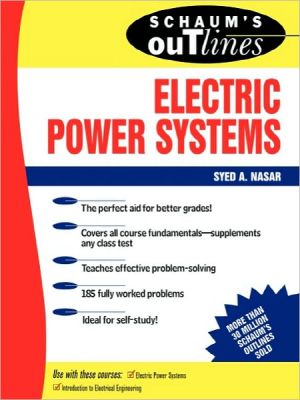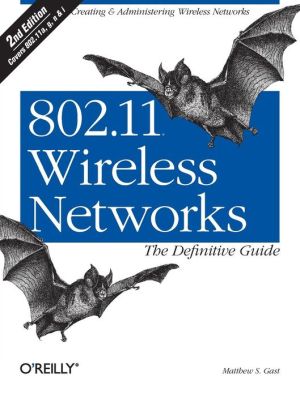Electrical Engineering: Principles and Applications
KEY BENEFIT: Electrical Engineering helps readers learn electrical engineering fundamentals with minimal frustration. Its goals are to present basic concepts in a general setting, to show readers how the principles of electrical engineering apply to specific problems in their own fields, and to enhance the overall learning process. Circuit analysis, digital systems, electronics, and electromechanics are covered.\ KEY TOPICS: Resistive Circuits; Inductance and Capacitance; Transients;...
Search in google:
For undergraduate introductory or survey courses in electrical engineering. ELECTRICAL ENGINEERING: PRINCIPLES AND APPLICATIONS, 5/e helps students learn electrical-engineering fundamentals with minimal frustration. Its goals are to present basic concepts in a general setting, to show students how the principles of electrical engineering apply to specific problems in their own fields, and to enhance the overall learning process. Circuit analysis, digital systems, electronics, and electromechanics are covered. A wide variety of pedagogical features stimulate student interest and engender awareness of the material’s relevance to their chosen profession. Booknews Surveys electrical engineering for non-majors in their third or fourth year of study. Chapters proceed through the basic concepts of electrical circuits, electronics (analog and digital), and electromechanics. Each chapter includes a statement of objectives, worked examples, exercises with answers, an end-of-chapter summary, and homework problems. Annotation c. by Book News, Inc., Portland, Or.
As in the first edition, my guiding philosophy in writing this book has three elements. The first element is my belief that in the long run students are best served by learning basic concepts in a general setting. Second, I believe that students need to be motivated by seeing how the principles apply to specific and interesting problems in their own fields. The third element of my philosophy is to take every opportunity to make learning free of frustration for the student. This book covers circuit analysis, digital systems, electronics, and electromechanics at a level appropriate for either electrical-engineering students in an introductory course or nonmajors in a survey course. The only essential prerequisites are basic physics and single-variable calculus. Teaching a course using this book offers opportunities to develop theoretical and experimental skills and experiences in the following areas: Basic circuit analysis and measurement First- and second-order transients Steady-state ac circuits Resonance and frequency response Digital logic circuits Microcontrollers (68HC11) Computer-based instrumentation, including LabVIEW Diode circuits Electronic amplifiers Field-effect and bipolar junction transistors Operational amplifiers Transformers Ac and dc motors Computer-aided circuit analysis (PSpice) While the emphasis of this book is on basic concepts, a key feature is the inclusion of short articles scattered throughout showing how electrical-engineering concepts are applied in other fields. The subjects of these articlesinclude anti-knock signal processing for internal combustion engines, a cardiac pacemaker, active noise control, and the use of the Global Positioning System in surveying, among others. I welcome comments from users of this book. Information on how the book could be improved is especially valuable and will be taken to heart in future revisions. My e-mail address is arhamble@mtu.edu SOFTWARE Two CDs are included with this book. One contains the evaluation version of LabVIEW 6I which is briefly discussed in Section 9.4. LabVIEW has become the industry standard software package for engineering instrumentation and testing. The intention is to make students aware of how LabVIEW coupled with a personal computer and a data acquisition board can be used to rapidly create special-purpose instrumentation and control systems. Later when they have the need to design such systems, they will have enough knowledge to establish a proper direction for further development of their computer-aided instrumentation skills. The second CD contains Orcad Family Release 9.2 Lite Edition. This is a powerful suite of programs produced by Cadence Systems for circuit analysis and design. In Appendix D, we show how to use Capture for entering circuit diagrams and setting up analyses, PSpice for analyzing the circuit, and Probe for viewing results. A number of circuits selected from throughout the book, starting in Chapter 2, are taken as examples. Students find computer-aided analysis to be an effective method for extending their "feel" for circuits and for checking some of the answers obtained through traditional analysis. Besides the evaluation programs, the virtual instruments (LabVIEW programs) and circuit files discussed in the book are included on the CDs. Furthermore, solutions to the in-chapter exercises, answers for selected end-of-chapter problems, and summaries of key equations for each chapter are included in pdf files on both CDs. CHANGES AND NEW FEATURES IN THE SECOND EDITION New chapter entitled Computer-Based Instrumentation Systems (Chapter 9) Extensive revision of the chapter on microcontrollers now featuring the 68HCll (Chapter 8) Earlier treatment of digital systems (Part II) Extensive revision of the chapter on field-effect transistors to emphasize MOS devices (Chapter 12) New section on digital signal processing (Section 6.9) New section on stepper motors (Section 17.5) Minor revisions of the remainder of the book Approximately 20% more end-of-chapter problems Revision and consolidation of the computer-aided circuit analysis material (Appendix D) Inclusion of a CD containing the evaluation version of LabVIEW 6I and the virtual instruments discussed in the book Inclusion of a second CD containing the evaluation version of Orcad Lite 9.2 and the circuit files discussed in the book Complete solutions to the in-chapter exercises (in pdf files on both CDs) Answers to selected end-of-chapter problems (in pdf files on both CDs) Summaries of key equations for each chapter (in pdf files on both CDs) Revision of the entire solutions manual New web site http://www.prenhall.com/hambley that contains the pdf files mentioned above, updates, instructor resources, and links to interesting sites related to material discussed in the book PREREQUISITES The essential prerequisites for a course from this book are basic physics and single-variable calculus. A prior differential equations course would be helpful but is not essential. Differential equations are encountered in Chapter 4 on transient analysis, but the skills needed are developed from basic calculus. PEDAGOGICAL FEATURES The book includes various pedagogical features designed with the goal of stimulating student interest, eliminating frustration, and engendering an awareness of the relevance of the material to their chosen profession. These features are: Statement of learning objectives open each chapter Comments in the margins emphasize and summarize important points or indicate common pitfalls that students need to avoid Short boxed articles demonstrate how electrical-engineering principles are applied in other fields of engineering. For example, see the articles on active noise cancellation (page 253) and electronic pacemakers (starting on page 348). Step-by-step problem solving procedures. For example, see the step-by-step summary of node-voltage analysis (on pages 70-71) or the summary of Théevenin equivalents (on page 86). Complete solutions to the in-chapter exercises included as pdf files on both of the CDs provide students with help Answers to approximately one-third of the end-of-chapter problems, provided as pdf files on both CDs, build student confidence and indicate where additional study is needed Summaries of important points at the end of each chapter provide references for students Key equations highlighted in the book and provided as pdf files on both CDs provide quick and convenient references for students MEETING ABET-DIRECTED OUTCOMES Courses based on this book provide excellent opportunities to meet many of the directed outcomes for accreditation. The Criteria for Accrediting Engineering Programs (for evaluations during the 2001-2002 accreditation cycle) require that graduates of accredited programs have "an ability to apply knowledge of mathematics, science, and engineering" and "an ability to identify, formulate, and solve engineering problems." This book, in its entirety, is aimed at developing these abilities. Also, graduates must have "an ability to design and conduct experiments, as well as analyze and interpret data." Chapter 9, Computer-Based Instrumentation Systems, helps to develop this ability. If the course includes a laboratory, this ability can be developed even further. Furthermore, the criteria require "an ability to function on multi-disciplinary teams" and "an ability to communicate effectively." Courses based on this book contribute to these abilities by giving nonmajors the knowledge and vocabulary to communicate effectively with electrical engineers. The book also helps to inform electrical engineers about applications in other fields of engineering. To aid in communication skills, end-of-chapter problems that ask students to explain electrical-engineering concepts in their own words have been added in this edition. The LabVIEW and Orcad PSpice software packages distributed with this book contribute to developing "an ability to use the techniques, skills, and modern engineering tools necessary for engineering practice." SOLUTIONS MANUAL AND WEB SITE Students can find solutions for the in-chapter exercises and answers (without solutions) for selected end-of-chapter problems on both of the CDs included with the book and on the web site. The web site also contains many links to interesting sites related to topics covered in the book. Any corrections that may be needed for the book or solutions manual will be posted on the web site as they are found. The home page for this book is located at http://www.prenhall.com/hambley INSTRUCTOR RESOURCES The web site also contains resources for instructors including: PowerPoint slides of key figures from the book Syllabus Builder™ Instructor's Manual Furthermore, a complete solutions manual is available from the publisher to instructors who have adopted the book. CONTENT AND ORGANIZATION Part I Circuits Chapter 1 defines current, voltage, power, and energy. Kirchhoff's laws are introduced. Voltage sources, current sources, and resistance are defined. Chapter 2 treats resistive circuits. Analysis by network reduction, node voltages, and mesh currents is covered. Thévenin equivalents, superposition, and the heatstone bridge are treated. Capacitance, inductance, and mutual inductance are treated in Chapter 3. Transients in electrical circuits are discussed in Chapter 4. First-order RL and RC circuits and time constants are covered followed by a discussion of second-order circuits. Chapter 5 considers sinusoidal steady-state circuit behavior. (A review of complex arithmetic is included in Appendix A.,) Power calculations, ac Thévenin and Norton equivalents, and balanced three-phase circuits are treated. Chapter 6 covers frequency response, Bode plots, resonance, and filters. The basic concept of Fourier theory (that signals are composed of sinusoidal components having various amplitudes, phases, and frequencies) is qualitatively discussed. A section on digital signal processing has been added in this edition. Part II Digital Systems Chapter 7 introduces logic gates and the representation of numerical data in binary form. It then proceeds to discuss combinatorial and sequential logic. Boolean algebra, De Morgan's laws, truth tables, Karnaugh maps, coders, decoders, flip flops, and registers are discussed. Chapter 8 treats microcomputers with emphasis on embedded systems using the Motorola 68HCll as the primary example. Computer organization and memory types are discussed. Digital process control using microcontrollers is described in general terms. Finally, selected instructions and addressing modes for the 68HCll are described. Assembly language programming is treated very briefly. Chapter 9, which is new in the second edition, discusses computer-based instrumentation systems including measurement concepts, sensors, signal conditioning, and analog-to-digital conversion. The chapter ends with a discussion of LabVIEW including an example virtual instrument that students can duplicate using the evaluation version on their own computers. Part III Electronics Chapter 10 presents the diode, its various models, load-line analysis, and diode circuits such as rectifiers, Zener-diode regulators, and wave-shapers. In Chapter 11, the specifications and imperfections of amplifiers that need to be considered in applications are discussed from a users perspective. These include gain, input impedance, output impedance, loading effects, frequency response, pulse response, nonlinear distortion, common-mode rejection, and dc offsets. Chapter 12 contains a totally revised treatment of the MOS field-effect transistor, its characteristic curves, load-line analysis, large-signal and small-signal models, bias circuits, the common-source amplifier, and the source follower. Chapter 13 gives a similar treatment for bipolar transistors. If desired, the order of Chapters 12 and 13 can be reversed. Another possibility is to skip most of both chapters so more time can be devoted to other topics. Chapter 14 treats the operational amplifier and many of its applications. Non-majors can learn enough from this chapter to design and use op-amp circuits for instrumentation applications in their own fields. Part IV Electromechanics Chapter 15 reviews basic magnetic field theory, analyzes magnetic circuits, and presents transformers. Dc machines and ac machines are treated in Chapters 16 and 17, respectively. The emphasis is on motors rather than generators because the nonelectrical engineer applies motors much more often than generators. In Chapter 16, an overall view of motors in general is presented before considering do motors, their equivalent circuits, and performance calculations. The universal motor and its applications are discussed. Chapter 17 deals with ac motors starting with the three-phase induction motor. Synchronous motors and their advantages with respect to power-factor correction are analyzed. Small motors including single-phase induction motors are also discussed. A section on stepper motors has been added. ACKNOWLEDGMENTS I especially want to thank Michigan Technological University President Curt Tompkins and the Chair of my department, Dr. Tim Schulz, for their support. I also wish to thank my colleagues, past and present, in the Electrical and Computer Engineering Department at Michigan Technological University, all of whom have given me help and encouragement at one time or another in writing this book and in my other projects.
Practical Applications of Electrical Engineering PrinciplesviContentsviiPrefacexiPart 1Circuits11Introduction21.1Overview of Electrical Engineering31.2Circuits, Currents, and Voltages71.3Power and Energy151.4Kirchhoff's Current Law181.5Kirchhoff's Voltage Law211.6Introduction to Circuit Elements241.7Introduction to Circuits33Summary36Problems372Resistive Circuits432.1Resistances in Series and Parallel442.2Network Analysis by Using Series and Parallel Equivalents482.3Voltage-Divider and Current-Divider Circuits522.4Node-Voltage Analysis572.5Mesh-Current Analysis722.6Thevenin and Norton Equivalent Circuits802.7Superposition Principle932.8Wheatstone Bridge96Summary99Problems1003Inductance and Capacitance1093.1Capacitance1103.2Capacitances in Series and Parallel1193.3Physical Characteristics of Capacitors1203.4Inductance1243.5Inductances in Series and Parallel1303.6Practical Inductors1313.7Mutual Inductance133Summary135Problems1364Transients1424.1First-Order RC Circuits1434.2DC Steady State1474.3RL Circuits1494.4RC and RL Circuits with General Sources1544.5Second-Order Circuits161Summary175Problems1765Steady-State Sinusoidal Analysis1815.1Sinusoidal Currents and Voltages1825.2Phasors1875.3Complex Impedances1935.4Circuit Analysis with Phasors and Complex Impedances1985.5Power in AC Circuits2045.6Thevenin and Norton Equivalent Circuits2175.7Balanced Three-Phase Circuits223Summary235Problems2376Frequency Response, Bode Plots, and Resonance2446.1Fourier Analysis, Filters, and Transfer Functions2456.2First-Order Lowpass Filters2546.3Decibels, the Cascade Connection, and Logarithmic Frequency Scales2596.4Bode Plots2646.5First-Order Highpass Filters2676.6Series Resonance2716.7Parallel Resonance2776.8Ideal and Second-Order Filters2806.9Digital Signal Processing286Summary297Problems298Part 2Digital Systems3077Logic Circuits3087.1Basic Logic Circuit Concepts3097.2Representation of Numerical Data in Binary Form3127.3Combinatorial Logic Circuits3207.4Synthesis of Logic Circuits3297.5Minimization of Logic Circuits3367.6Sequential Logic Circuits339Conclusions351Summary351Problems3528Microcomputers3568.1Computer Organization3578.2Memory Types3608.3Digital Process Control3638.4The Motorola 68HC11/123668.5The Instruction Set and Addressing Modes for the 68HC113728.6Assembly-Language Programming381Summary386Problems3879Computer-Based Instrumentation Systems3909.1Measurement Concepts and Sensors3919.2Signal Conditioning3969.3Analog-to-Digital Conversion4029.4LabVIEW405Summary417Problems418Part 3Electronics42110Diodes42210.1Basic Diode Concepts42310.2Load-Line Analysis of Diode Circuits42710.3Zener-Diode Voltage-Regulator Circuits42910.4Ideal-Diode Model43410.5Piecewise-Linear Diode Models43610.6Rectifier Circuits44010.7Wave-Shaping Circuits44410.8Linear Small-Signal Equivalent Circuits450Summary456Problems45711Amplifiers: Specifications and External Characteristics46511.1Basic Amplifier Concepts46611.2Cascaded Amplifiers47211.3Power Supplies and Efficiency47511.4Additional Amplifier Models47811.5Importance of Amplifier Impedances in Various Applications48211.6Ideal Amplifiers48411.7Frequency Response48611.8Linear Waveform Distortion49111.9Pulse Response49511.10Transfer Characteristics and Nonlinear Distortion49911.11Differential Amplifiers50211.12Offset Voltage, Bias Current, and Offset Current506Summary512Problems51212Field-Effect Transistors52112.1NMOS and PMOS Transistors52212.2Load-Line Analysis of a Simple NMOS Amplifier53012.3Bias Circuits53312.4Small-Signal Equivalent Circuits53612.5Common-Source Amplifiers54112.6Source Followers54512.7CMOS Logic Gates550Summary554Problems55413Bipolar Junction Transistors55913.1Current and Voltage Relationships56013.2Common-Emitter Characteristics56313.3Load-Line Analysis of a Common-Emitter Amplifier56513.4pnp Bipolar Junction Transistors57213.5Large-Signal DC Circuit Models57413.6Large-Signal DC Analysis of BJT Circuits57713.7Small-Signal Equivalent Circuits58413.8Common-Emitter Amplifiers58813.9Emitter Followers593Summary599Problems59914Operational Amplifiers60714.1Ideal Operational Amplifiers60814.2Summing-Point Constraint61014.3Inverting Amplifiers61014.4Noninverting Amplifiers61714.5Design of Simple Amplifiers62014.6Op-Amp Imperfections in the Linear Range of Operation62614.7Nonlinear Limitations63014.8DC Imperfections63514.9Differential and Instrumentation Amplifiers64014.10Integrators and Differentiators64214.11Active Filters645Summary650Problems651Part 4Electromechanics66115Magnetic Circuits and Transformers66215.1Magnetic Fields66315.2Magnetic Circuits67315.3Inductance and Mutual Inductance67915.4Magnetic Materials68315.5Ideal Transformers68615.6Real Transformers695Summary699Problems70016DC Machines70816.1Overview of Motors70916.2Principles of DC Machines71816.3Rotating DC Machines72416.4Shunt-Connected and Separately Excited DC Motors73116.5Series-Connected DC Motors73616.6Speed Control of DC Motors740Summary746Problems74717AC Machines75317.1Three-Phase Induction Motors75417.2Equivalent-Circuit and Performance Calculations for Induction Motors76217.3Synchronous Machines77217.4Single-Phase Motors78517.5Stepper Motors789Summary790Problems791AComplex Numbers797Summary805Problems805BNominal Values and the Color Code for Resistors806CPreparing for the Fundamentals of Engineering Exam808DComputer-Aided Circuit Analysis814D.1Analysis of DC Circuits814D.2Transient Analysis823D.3Frequency Response827D.4Other Examples830ESoftware Installation833Index835
\ BooknewsSurveys electrical engineering for non-majors in their third or fourth year of study. Chapters proceed through the basic concepts of electrical circuits, electronics (analog and digital), and electromechanics. Each chapter includes a statement of objectives, worked examples, exercises with answers, an end-of-chapter summary, and homework problems. Annotation c. by Book News, Inc., Portland, Or.\ \
